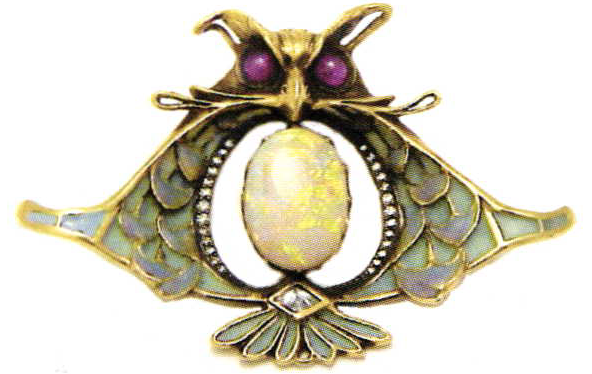Laser Welding Plique a Jour Owl Brooch
3 Minute Read
Laser welders, it seems, have as many applications as there are imaginations and types of jewelry. This laser welding project replaces the pin stem and clutch on a "Plique ajour," opal, and ruby owl brooch.
Just a bit of information on the Plique a Jour Technique
The Dictionary of Enameling by Erika Speel defines Plique-a-Jour as "Translucent or Opalescent Enamels fused to span across a network of cells formed with gold, silver, silvered copper, or copper, without a backing under the glazed.areas. The fused enamel is an integral part ofthe finished surface, with the glaze forming a shell veined with metal outlines. Plique-a-jour is seen to best effect when lit strongly from the back. Lacking such illumination the enamels tend to look dense or semi-opaque. Plique-a-jour has been in fashion since the late 19th century for jewelry and small decorative articles. Although visually very alluring, plique-a-jour pieces are more fragile than other types of enamel work and require careful handling in use."
Be thankful for laser welding technology!
This particular brooch is missing the pin stem and Clutch. We will laser weld new pieces in place and use a couple of masking techniques to protect the fragile enamel.
Now that the old clutch has been removed, what measures can we take to protect the brooch from damage from the laser? Obvious potential problems include overheating, penetrating through the metal, ricochet, and direct pulse to a sensitive area.
To keep from overheating the piece, hold the piece in your fingers while welding. This technique is almost always most desirable and appropriate for control and safety. Holding it in your fingers allows you to feel how hot the piece is getting as you are working on it. You can also use the air nozzle inside your laser to help cool the piece.
You can use a less powerful setting to begin and thereby avoid penetrating through the piece. If necessary gradually increase the milliseconds or decrease the beam width first, before increasing the voltage.
As for the problem of ricochet or direct pulse to sensitive areas, masking the piece seems to work well. A couple of techniques to mention here are the use of a putty called "plasti-tac" and the use of a Sterling silver tool/template.
The highly reflective silver will shield the sensitive areas and provide excellent protection against ricochet and a stray direct pulse to an unwanted area. One note: be sure to keep the silver template free of oxides from the laser pulses. Silver works well when shiny, but it absorbs the full pulse when darkened by oxides. Cut your template to meet the needs of the job.
- Special thanks to Richard McMullen for his expertise in my research of plique a jour.
You assume all responsibility and risk for the use of the safety resources available on or through this web page. The International Gem Society LLC does not assume any liability for the materials, information and opinions provided on, or available through, this web page. No advice or information provided by this website shall create any warranty. Reliance on such advice, information or the content of this web page is solely at your own risk, including without limitation any safety guidelines, resources or precautions, or any other information related to safety that may be available on or through this web page. The International Gem Society LLC disclaims any liability for injury, death or damages resulting from the use thereof.
The All-In-One Jewelry Making Solution At Your Fingertips
When you join the Ganoksin community, you get the tools you need to take your work to the next level.
Trusted Jewelry Making Information & Techniques
Sign up to receive the latest articles, techniques, and inspirations with our free newsletter.
